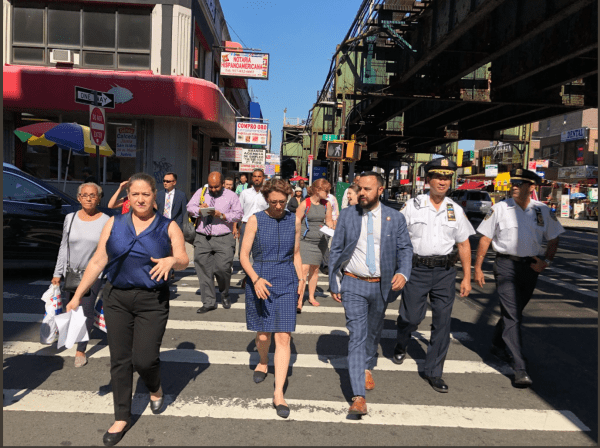
(Photo: Office of Francisco Moya/ Twitter)
July 2, 2018 By Tara Law
Elected officials called on the DOT to end the Clear Curbs project on Roosevelt Avenue last Friday, citing the project’s negative impact on local businesses.
The six month pilot project, which the DOT implemented in March, aims to reduce traffic along the avenue by prohibiting deliveries and standing on both sides of the roadway between Broadway and 90th Street from 7 p.m. to 10 a.m. and 4 p.m. to 7 p.m.
The Clear Curbs program aims to reduce congestion on Roosevelt Avenue by preventing cars from blocking travel lanes. The project also aims to expedite the quick pick-up and drop-off of passengers.
The project has been attacked by many local residents and business owners, who say that the restrictions have made it difficult for drivers to park and to access businesses along the thoroughfare.
Lawmakers, including Councilmembers Francisco Moya and Mark Gjonaj (D-Bronx), criticized the project after touring the area with DOT Commissioner Polly Trottenberg. They argue that the DOT failed to adequately consult with local businesses before starting the pilot and said that the project has crippled local stores.
Councilmember Gjonaj, the chair of the Council’s Committee on Small Business, called on the DOT to put a stop to the project.
“Clear Curbs has cleared out small businesses,” said Gjonaj, the chair of the Committee on Small Business. “We don’t need six months to know that this has been a disaster for small businesses and should be immediately ended.”
Gjonaj also promoted a bill, co-sponsored by Councilmember Moya and Majority Leader Laurie Cumbo, that would require the DOT to notify council members, community boards, and business improvement districts about projects before the DOT implements significant traffic changes. Each stakeholder would have 10 days to comment on the project after notification.
The bill, called “The Protect NYC Jobs and Businesses Act,” would kick in before the DOT eliminates a traffic lane, 500 continuous feet of parking, or three blocks of street usage for more than a week. The bill is currently in committee.
Moya argued that the DOT failed to consult with the businesses before implementing the project on Roosevelt Avenue.
“Clear Curbs has decimated business along Roosevelt Avenue,” said Moya. “Small business owners here fear they may have to shutter their shops before the pilot program even wraps up in a few months.”
A DOT spokesperson said in an email today that the department is reviewing feedback from elected officials and “other stakeholders,” and that the DOT will hold a follow-up discussion on the pilot program. The DOT is also working with Small Business Services, which will reach out to the businesses.
The DOT also disputed claims that the department failed to reach out to the community before launching the pilot.
The DOT claims that the agency met with the Jackson Heights and Elmhurst community boards on Jan. 17 to discuss the program, and met with elected officials and business representatives after the mayor announced the Congestion Action Plan in October.
The DOT also distributed fliers door-to-door at businesses in the pilot area, the spokesperson said..
“Since implementation, DOT has demonstrated its interest and accessibility in gathering feedback on the pilot,” the spokesperson said. “This is reflected in last Friday’s meeting with elected officials as well as several discussions, walk-throughs and meetings during the past 3 months with the 82nd Street BID and both community board.”
However, the councilmembers’ statements against the project echoed the outcry among many local business owners.
Local business owners, including David Betancourt–owner of the 82nd Street restaurant Delicias Colombianas- spoke with the lawmakers during their visit.
Betancourt said that the DOT initiative is “killing our businesses.”
“We are down 50 percent since Clear Curbs started,” Betancourt said. “As a small business operator, we are struggling to keep our doors open.”
5 Comments






Moya has always been a total idiot! Time to get rid of him AND Peralta for good.
Clear curbs is the best idea we had implemented in Jackson heights in a while! Shop wonders need to understand that their delivery time is BEFORE business hours as it works like that all over the world. Clear curbs made it possible to take buses and taxis on roosevelt. Also a lot of residents who drive are not stuck for 20 minutes to move10 blocks anymore. They should extend this program for the whole roosevelt Ave from Sunnyside to Grand central
Do these elected official represent businesses or residents? Clear Curbs has been a fantastic thing for the people who actually live here and use the bus. With Clear Curbs, buses can actually travel on Roosevelt. As long as the shopowners as a special interest group have a veto on every positive change in this city, our mobility will continue to suffer. Short of having dedicated bus lane on Roosevelt, Clear Curbs is the next best thing.
The traffic on 37th Avenue goes for at least 4 blocks somedays. They need to ticket vehicles idling more than 5 minutes on Roosevelt Ave.
They do that in Hoboken. It works.